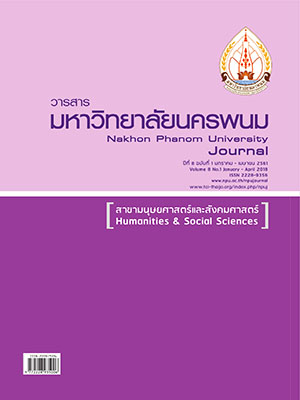การศึกษาสถานการณ์การค้าของผู้ประกอบการบริเวณ ด่านช่องจอม จังหวัดสุรินทร์
Main Article Content
Abstract
The objectives of this study were to investigate: 1) general data of entrepreneurs who sold products made in Thailand, 2) preliminary logistics data of products sold by entrepreneurs, 3) factors that affected the trade at the Chong Chom border crossing point, 4) SWOT analysis of entrepreneurs’ businesses at the Chong Chom border crossing point, and 5) competitiveness at the Chong Chom border crossing point. This study was a survey research, and population in the study was entrepreneurs who sold products at the Chong Chom border crossing point, especially sold domestic products. By using a small population sample size, the questionnaire data from 40 entrepreneurs were collected in July 2016. The descriptive statistics were used to analyze the results.
The findings were as follows: 1) most entrepreneurs were females with five-year business experience or less, whose products sold were bicycles, clothes, and kitchen utensils. 2) For the logistics of products, materials and products were mostly transported by private car, stored in shops and sold in front of stores. This study found that 1) most entrepreneurs were female and with less than five year business experience. Most of the products sold were bicycles, clothing and kitchen utensils. 2) For the logistics of product, materials and products were mostly transported by private car, stored in shops and sold in front of stores. 3) The factors that affected border trade at high level were: the change of the political regime in the country, the regulations of the government, the unrest in border areas, and the prices on the rise. 4) The strengths and opportunities of businesses were the low price of products, the variety of products and the products being promoted by the government. The weaknesses and treats were a lack of language skills, and a lack of experience in trade. 5) The results of analyzing variables of the diamond model which came from collection of secondary and questionnaire data in the demand condition found that domestic customers’ demand for goods increased, while Cambodian customers decreased. As for the production factor condition, it found that there was a variety of low-price products but a lack of technology application. As for the competition and strategy, it found that there was a cartel but there was a competition in price. As for the related industries and the governments, it found that there were supports from both governments of two countries, and Surin province has been promoted to be an ASEAN market, but the government also added measures to organize the border trade and increase the import tariffs.
Article Details
References
กาญจนา ธรรมาวาท. (2545). วิธีวิจัยทางเศรษฐศาสตร์. สำนักพิมพ์มหาวิทยาลัยรามคำแหง กรุงเทพฯ : มหาวิทยาลัยรามคำแหง.
จาตุรงค์ เพ็งพรนัฒน์ มาลี ไชยเสนา และสุวภัทร ศรีจองแสง. (2560). ยุทธศาสตร์การพัฒนาการท่องเที่ยวชายแดนไทย-กัมพูชาบริเวณจังหวัดศรีสะเกษภายใต้ยุทธศาสตร์ความร่วมมือทางเศรษฐกิจอิรวดี-เจ้าพระยา-แม่โขง. วารสารมหาวิทยาลัยนครพนม. 7(1) : 81-89.
ณัฏฐ์ธนิน เอื้อศิลป์. (2560). แสดงบรรยากาศของประตูทางเข้าด่านหนองคาย จังหวัดหนองคาย : มหาวิทยาลัยขอนแก่น วิทยาเขตหนองคาย.
. (2560). แสดงสินค้าหัตถกรรมที่จำหน่ายในบริเวณด่านช่องจอม จังหวัดสุรินทร์. มหาวิทยาลัยขอนแก่น วิทยาเขตหนองคาย.
มณีรัตน์ การรักษ์. (2558). การพัฒนาตลาดการค้าชายแดนไทย-กัมพูชากรณีศึกษาตลาดการค้าชายแดนช่องจอม จังหวัดสุรินทร์. วารสารมหาวิทยาลัยนครพนม. 5(1) : 35-43.
เรวดี แก้วมณี. (2556). แนวโน้มการค้าชายแดนสดใส โอกาสของภาคอุตสาหกรรมภายใต้ยุคค่าเงินบาทผันผวน. สืบค้นเมื่อพฤษภาคม, 2560, จาก; http://www.oie.go.th/sites/default/files/attachments/article /trendbordertrade-june2556.pdf.
ศูนย์ปฏิบัติการร่วมกลุ่มจังหวัดภาคตะวันออกเฉียงเหนือ และสถานบันยุทธศาสตร์ภาคตะวันออกเฉียงเหนือ มหาวิทยาลัยขอนแก่น. (2557). การค้าตามแนวชายแดนของจังหวัดสุรินทร์. ขอนแก่น : มหาวิทยาลัยขอนแก่น.
Jinachai, N., Anantachoti, P., & Winit-Watjana, W. (2016). Exploring competitiveness of Thailand’s cosmetic industry using porter’s diamond model. Thai Journal of Pharmaceutical Sciences. 40(4), 172-178.
Porter, M., E. (1998). The competitive advantage of nations. Free press edition. New York.


